The Seiko SKX173 is sometimes overshadowed by its more sought-after sister, the SKX007, but it remains a highly capable dive watch that offers a different dial while maintaining the same rugged dependability. With its distinct dial design and ISO-certified durability, the SKX173 has long been a favorite among enthusiasts.
I bought my SKX173 at my dad’s and grandfather’s shop when I was working for him around 2008. I wanted an analog watch and, specifically, an automatic (or as my watchmaker grandfather called, “a real watch.”) I also wanted something that, with the simple change of a strap, could be made to wear in a wide variety of situations.
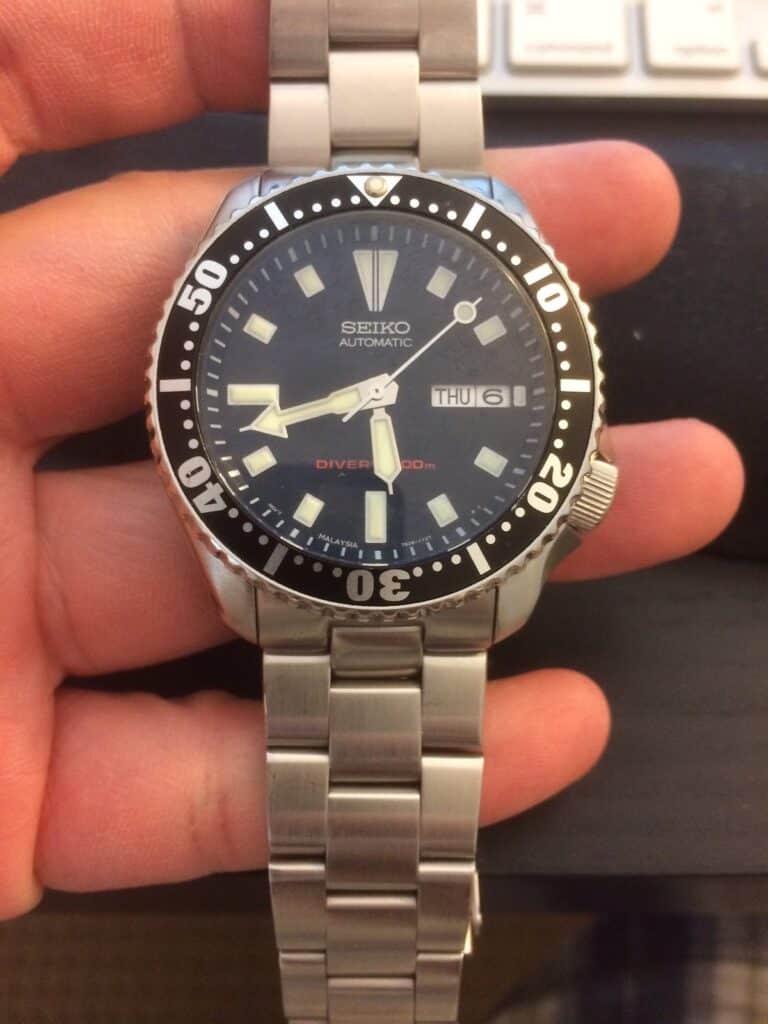
I’ve taken it boating, kayaking, swimming, snorkeling, hiking, and fishing, and it’s one of my favorite watches to wear to work.
Here’s why I think this watch stands out, where it holds its own against its more well-known sibling, why it’s one of my favorite pieces in my collection, and what I’m not so crazy about.
(For reviews on the SKX007, Two Broke Watch Snobs writers have given their thoughts here and here.)
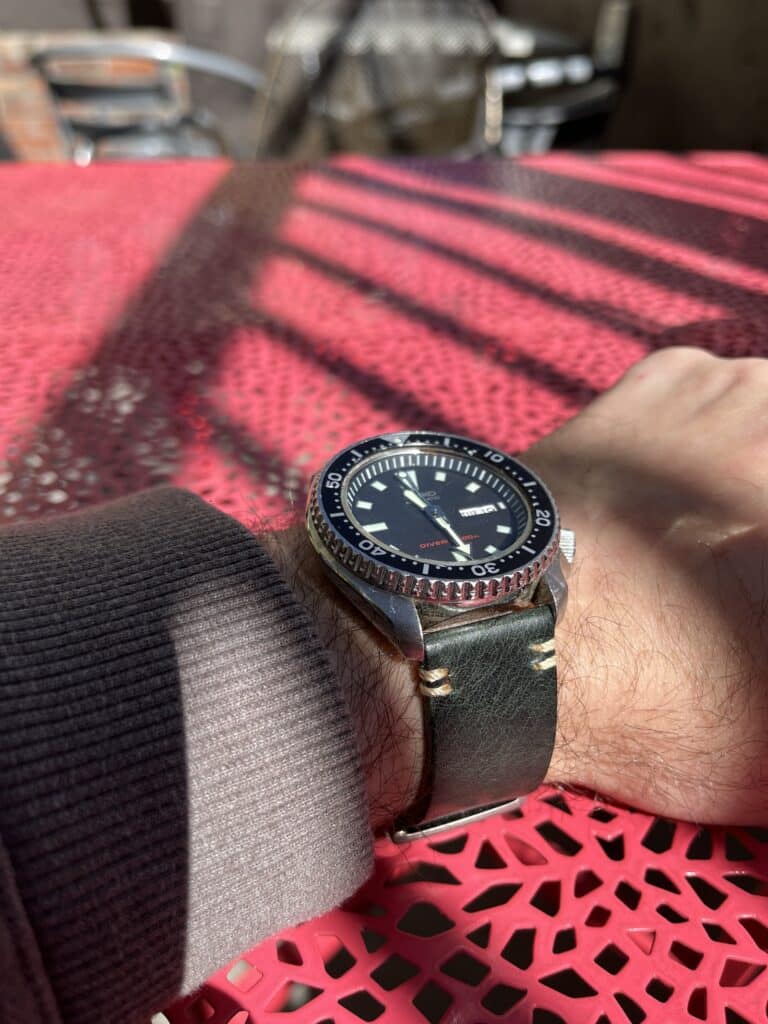
Movement
At the heart of the SKX173 is Seiko’s 7S26 automatic movement — the same workhorse found in the SKX007. This non-hand-winding, non-hacking movement operates at 21,600 vibrations per hour and offers a power reserve of about 40 hours. While it lacks the hand-winding and hacking features found in more modern automatic movements, the 7S26 has proven reliable, durable, and low-maintenance.
While probably ill-advised, I haven’t had the watch serviced once in 17 years. The only work I’ve needed done on it was the replacement of the bezel gasket about two years ago — something I failed brilliantly at trying to do myself (Right Time Watches in Denver handled this for me quickly and affordably and anyone in the area should check them out if they haven’t).
The lack of hand-winding may be a downside for some, especially those who rotate watches frequently, but the movement’s ability to withstand years of use with minimal servicing is a major advantage. Very few of my watches offer the feature, and it hasn’t been a problem, but twirling my watch around every morning is a fun way to start the day and get some blood flowing.
For a tool watch designed for rugged conditions, the 7S26 movement is more than adequate. It’s a movement built for longevity rather than precision, though you can expect an accuracy range of around -20 to +40 seconds per day, which is about standard for this type of movement.

Dial
One of the biggest differences between the SKX173 and the SKX007 is in the dial design. While the SKX007 features round indices, the SKX173 takes a different approach with rectangular markers and a tall, narrow trapezoid index at 12 o’clock that invokes a more military watch-inspired aesthetic. This gives it a look reminiscent of Seiko’s earlier dive watches and makes it a preferred choice for those who appreciate more angular and arguably legible markers.
The dial retains Seiko’s famous LumiBrite luminescence, and boasts the brightest glow of watches in my collection.
The day-date complication at 3 o’clock is a practical feature too. While some like just a date complication and others prefer a cleaner dial, I like being reminded of the day. Working odd hours in journalism, as I do, with lots of interviews, meetings, deadlines, and other time commitments throughout the day, it helps to quickly glance at my watch for the time, day of the week, and date.
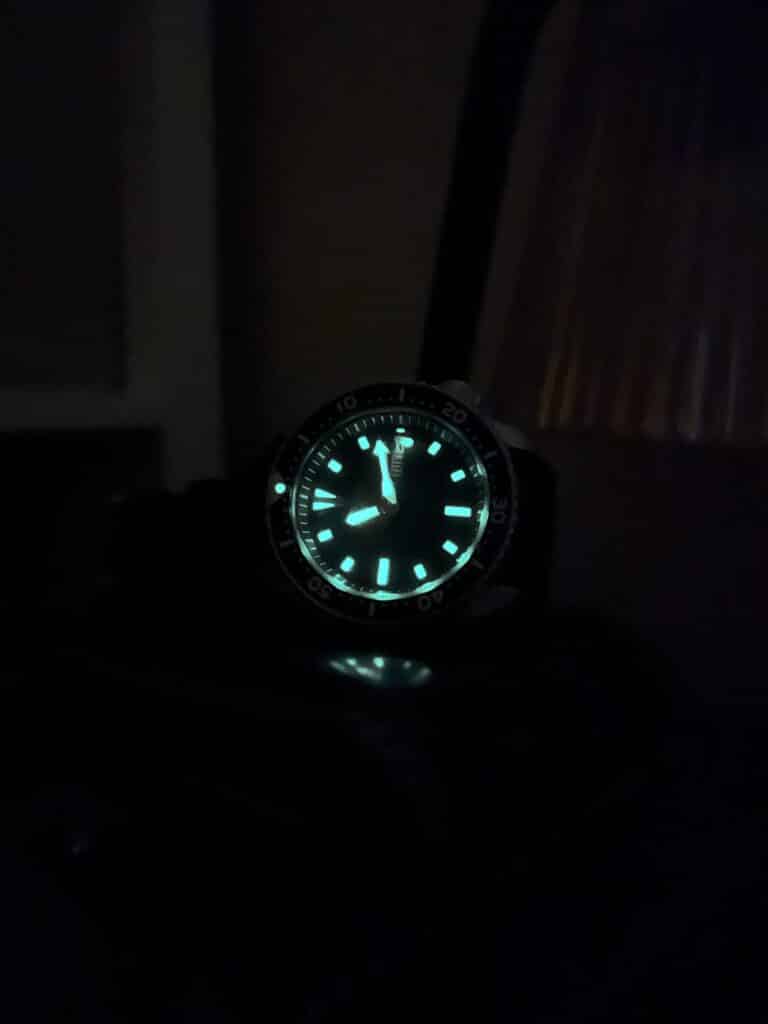
The rotating bezel is also equally helpful for timing ramen in the breakroom, parking meters in the city, and tons of other tasks — but more on that in the next section.
For those who appreciate a less often seen Seiko aesthetic while maintaining the same rugged functionality, the SKX173’s dial is an excellent alternative to the SKX007’s more classic dive-watch look.
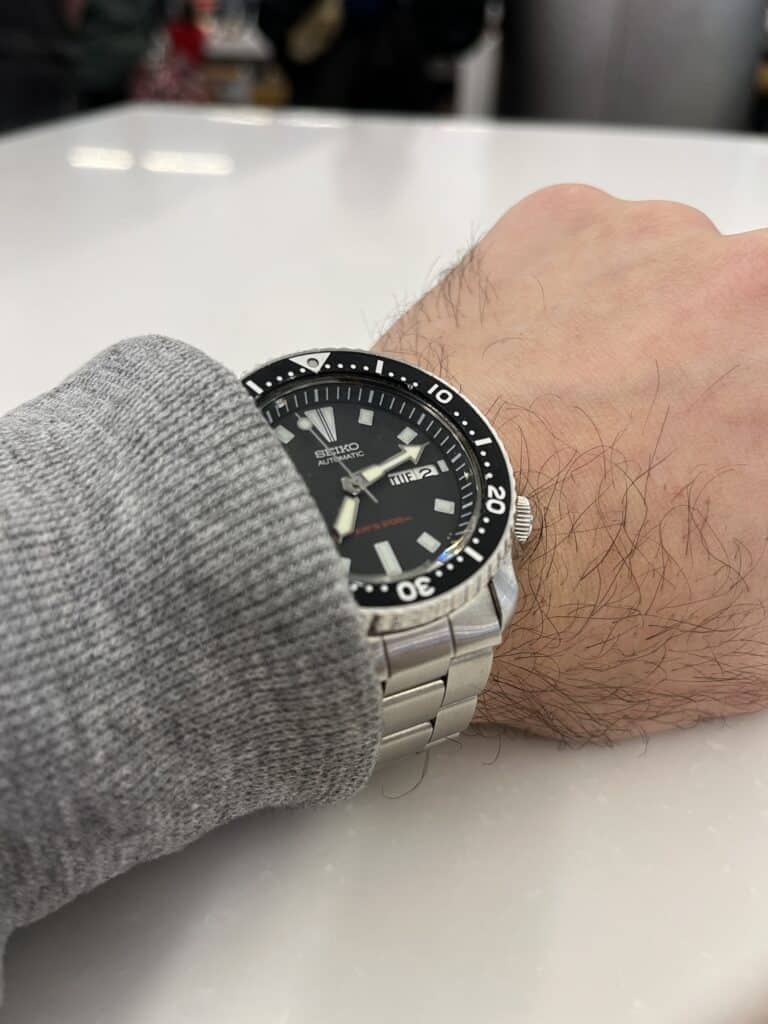
Case
The case of the SKX173 is nearly identical to the SKX007, with a 42mm diameter, a thickness of 13.25mm, and a lug-to-lug measurement of about 45.5mm. This case size gives it a substantial feel on the wrist without being overbearing, even on my small wrists, making it a great fit for most wrist sizes.
Constructed from stainless steel, the case is built for durability, featuring Seiko’s signature and comfortable cushion shape. The screw-down crown helps with the 200-meter water resistance and the crown being at 4 o’clock helps with comfort when you’re working with your hands. The ISO-6425 certification makes it a true dive watch, not just a diver-styled piece.

The unidirectional 120-click bezel is smooth (provided your gaskets are clean and intact) with a good positive “click.” While slightly looser than higher-end dive watches and even my Casio Duro, it remains smooth, solid, and easy to grasp, even with soft winter gloves on (I’d imagine it’s similar with dive gloves). The bezel insert is a standard black aluminum, which can be susceptible to wear over time, but it’s easy to replace for those who want to bring it back to life or modify their watch.
The SKX173 also carries design elements reminiscent of Seiko’s 7002 and slim-case 6309 divers, making it an attractive option for those who want a vintage-inspired look without the challenges of maintaining an older watch. The case shape is particularly close to that of the 7002 series — Seiko’s transition model before the SKX line — and bears similarities to the later variations of the 6309 “slim case” models, making it a suitable option for those who like the aesthetic of older models but prefer a modern watch with better water resistance and improved durability.
The SKX173 was produced in both Singapore and Malaysia, with case back markings indicating its country of origin. While they appear to be functionally identical, some people might want one or the other. At the time of writing, there are three of these on eBay identified as having been made in Singapore and one made in Malaysia, but also over 30 with no country of manufacture listed, so don’t take that count as an indication of rarity.
Seiko also offered the SKX series in two case sizes — the full-size 42mm version like the 173 and 007, and a smaller 38mm variant, often referred to as the SKX013 line.
The crystal is a Hardlex mineral, offering decent scratch resistance, though not as high as sapphire crystal. Mine definitely shows some scratches from over the years. While I can’t attribute any specific scratch to rugged outdoor use or clumsiness when it comes to door frames, I can say that the dial underneath remains perfectly legible despite those scratches, and that the crystals are relatively easy to find and replace (or have replaced, given your skills and tools).
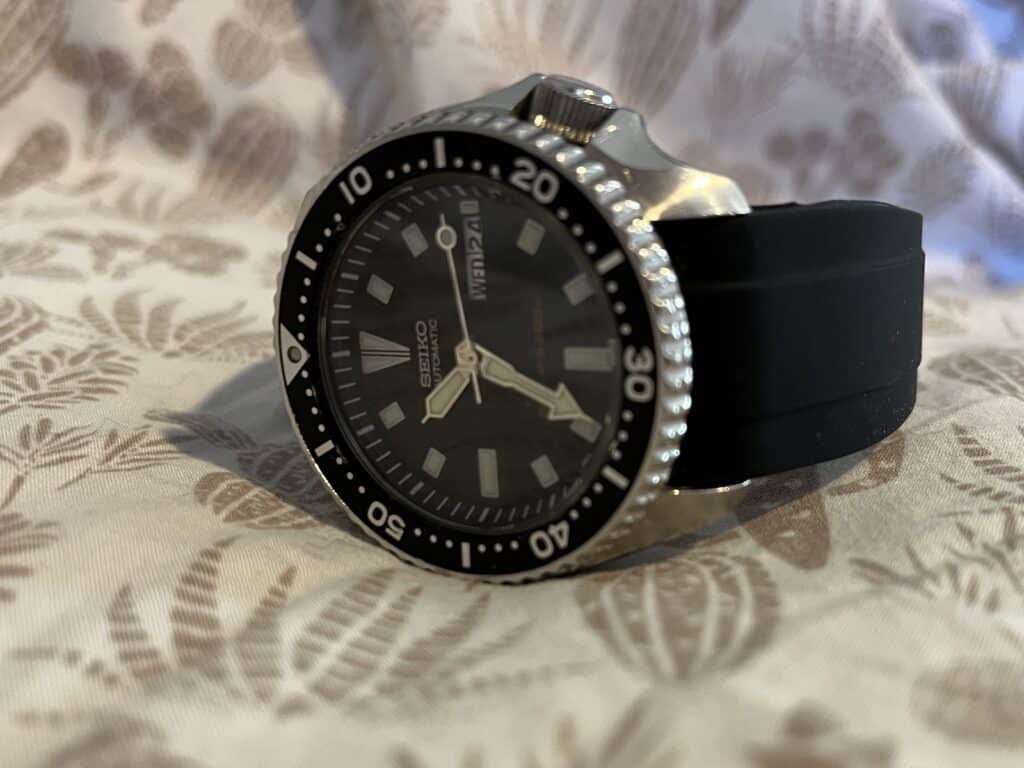
The Strap (and why you should probably swap it)
The SKX173 typically comes on a 22mm Seiko rubber strap, which, while comfortable and durable, has long been a controversial aspect of the SKX series. I and many other owners find the stock strap to be a bit stiff and bulky. I wore the original strap on it for years, but once I noticed it started to tear, I quickly swapped it for a NATO, which is what’s on my 173 most of the time.
My favorite is probably the BluShark Alpha in black, but it also looks great on orange, tan, olive green, gray, and various striped NATOS.
For those looking for alternatives, the SKX173 also pairs exceptionally well with NATO straps, rubber dive straps from third-party brands, or stainless steel bracelets like the jubilee, oyster, or even “beads of rice” designs. I prefer an oyster myself and often wear that on the watch, but a friend has the similar SKX011 with an orange dial on a jubilee and it looks great too.
When dressing it up, I’ll sometimes swap in a leather strap — I had a dark brown leather Hadley Roma strap on it for a few years and recently got a black BluShark double stitch leather strap that I’ve been enjoying.
For the regular trips I take to visit family in Florida, I often take a cheap fitted rubber strap I got on Amazon, which I like for the price, but I might eventually get a higher quality version of the same design.
The watch is definitely versatile enough to wear on a wide variety of straps and bracelets in different materials, colors, and designs.
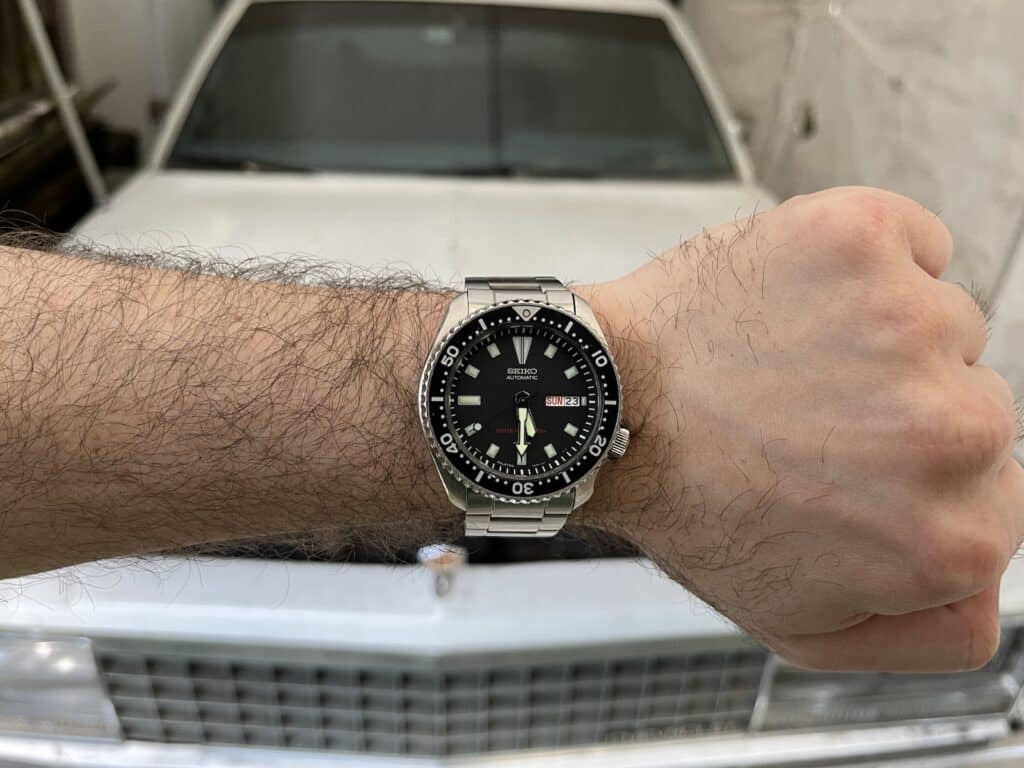
Cost on the used market
One of the most notable trends in the past few years has been the rising cost of SKX models, especially the SKX007. With the discontinuation of the SKX series, demand has driven up prices significantly.
If you’re after a Seiko dive watch with a slightly different dial aesthetic and the same robust build, the SKX173 remains a worthy option — but no longer necessarily a cheaper one.
The SKX173 has also seen a price increase on the secondary market. However, I’ve found that the 173 often rivals the price of the 007, despite historically being less desirable and maybe because of its relative rarity. While it used to be a more affordable alternative, recent market trends have pushed it closer to 007 pricing, making it more of a personal preference decision than a budget-conscious one, the way it might have been when these were in production.
Expect to pay anywhere between $400 to $600 for a good-condition SKX173, which is on par with or even slightly higher than the SKX007 in some cases, based on a quick scan of eBay and Chrono24. And while some 007 owners are asking $700 to over $1,000, many can be found for $200 to $400.
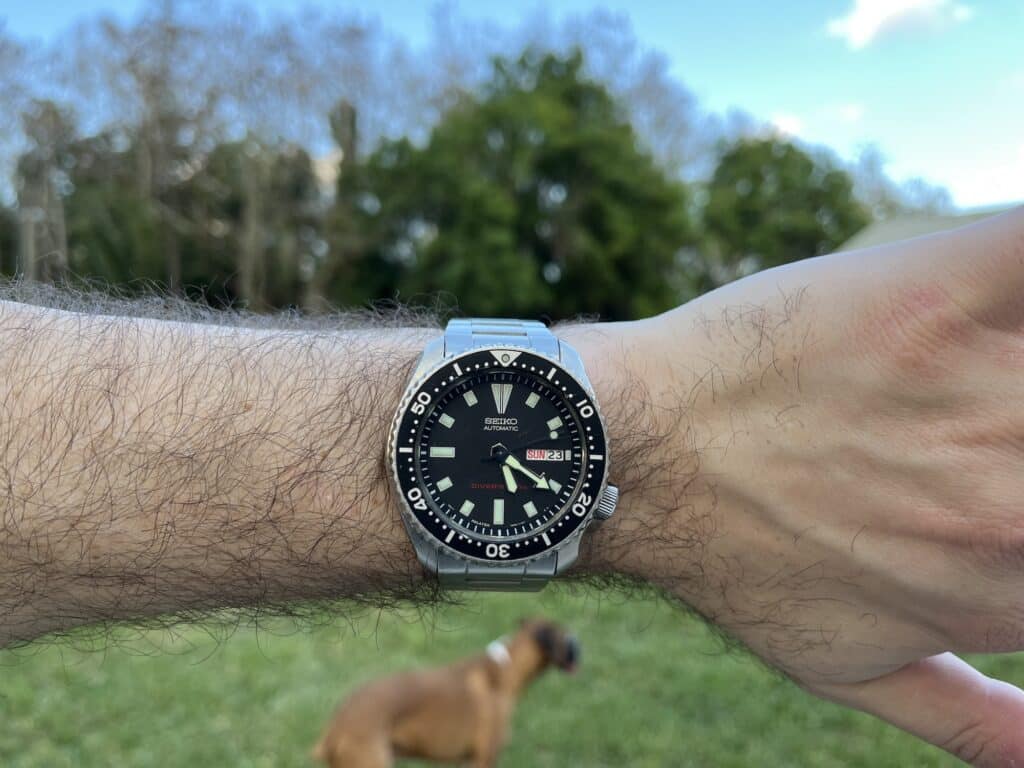
Final thoughts and alternatives
The SKX173 is a fantastic dive watch (though I haven’t gone diving with it) that delivers much of what enthusiasts love about the SKX line — rugged construction, reliable movement, and excellent water resistance — while offering a unique dial design that sets it apart. While it used to be a more budget-friendly alternative to the SKX007, today’s prices make it more of a rival than a substitute.
My only suggestion is to take care of it and swap out that strap. But hold onto the original because, if you ever intend to sell it, those on the used market with the original strap tend to fetch a higher asking price.
If there are design elements you don’t like or if you want something that’s currently offered, where the warranty won’t be a question, there are several options.
The Casio MDV106, commonly referred to as the “Duro,” is an excellent value quartz dive watch with a straightforward design and 200-meter water resistance and screw-down crown but without ISO certification. It’s larger at 44mm but noticeably thinner. While lacking the higher quality materials and fit and finish of the Seiko SKX line, these can often be had for around $50 to $100, depending on strap, sales, and where you buy it.
The Seiko 5 Sports SRPD55 is the closest you’ll get to the older SKX models. It’s almost identical in dimensions, has Seiko’s 4R36 movement, comes from the factory on a stainless steel oyster bracelet, and retails at $325 but can typically be found for closer to $250. Two Broke Watch Snobs reviewed the Seiko 5 Sports line here.
Orient, which is owned by Seiko, offers the Kamasu line, offering a classic dive watch design with a crown at 3 o’clock and black, blue, red, and green dials. Waterproofing is also advertised at 200m, but does not appear to be ISO-certified. The case is slightly slimmer, diameter slightly smaller, and lug-to-lug slightly longer. It’s similar but different enough to the SKX or Seiko 5 watches and can be had for around $250 to $350. TBWS reviewed it here.
From there, you can go up in quality and price to options like the Seiko SPB317, Tudor Pelagos, Omega Seamaster, or Rolex Submariner. The options are near endless.
But for those who seek a discontinued and arguably rarer Seiko, the SKX173 is a great choice. Whether as a collector’s item or a daily wear piece, it holds its own against the SKX007 and remains one of Seiko’s most respected dive watches.
And as my first automatic — one that I got at my dad and grandfather’s shop when I worked there — I’ll always hold on to this watch, as you can’t put a price on sentimentality.

The son and grandson of watchmakers, Austen became interested in watches in high school, while working part-time at his father and grandfather’s shop in South Florida. After college and over a decade working in journalism, he developed a passion for watches, growing his collection from a G-Shock and a Seiko SKX173 to over a dozen watches. A sucker for simple and classic designs, dive watches, or the occasional unique dial, his collection is modest and budget-minded, save an Omega “Pre-Bond” Seamaster 200m his father gifted him. When he’s not working as a full-time journalist or playing drums in his band, he’s cuddling with his cat Sox or hiking the mountains of Colorado where he lives with his fiancé.
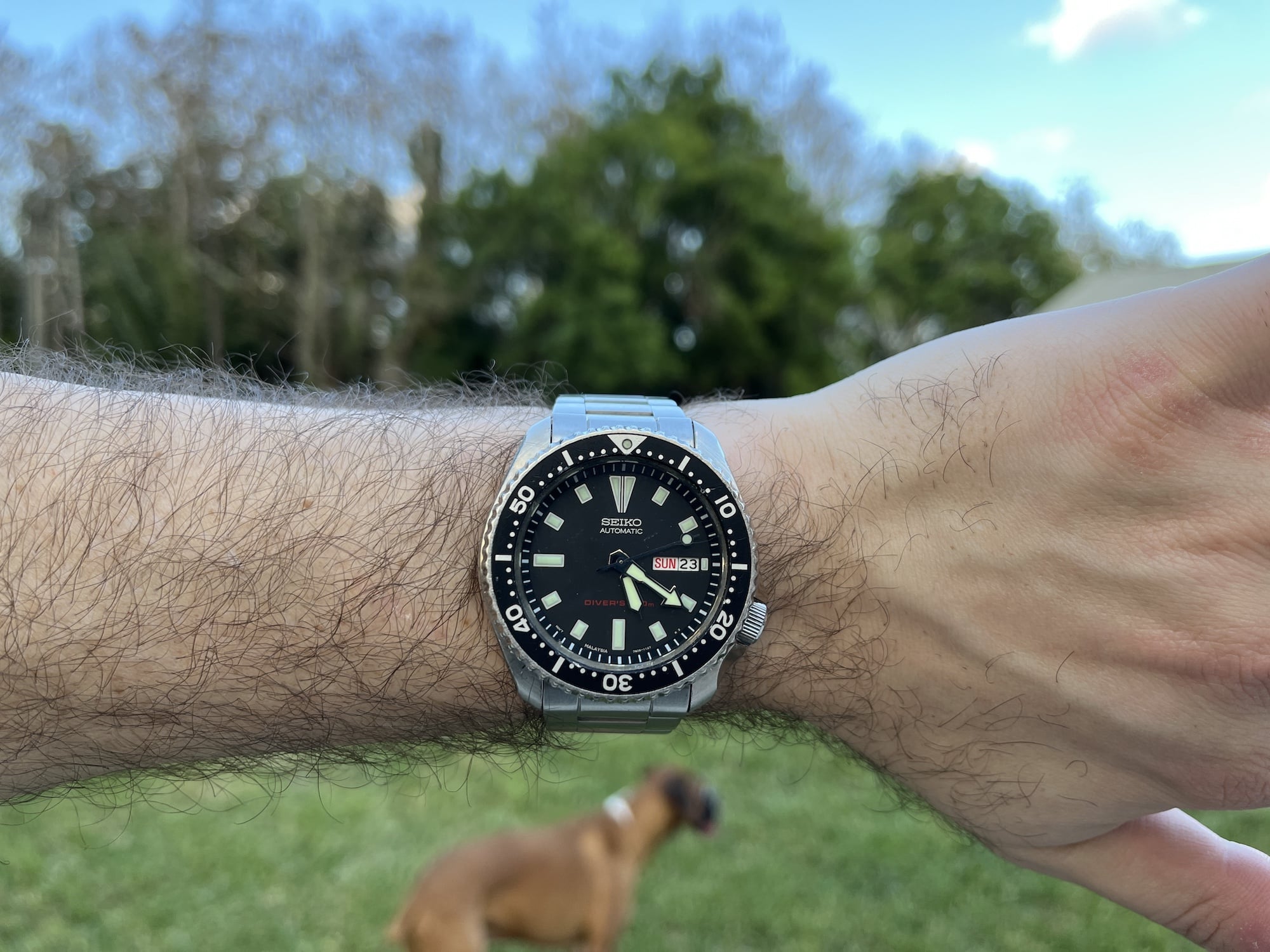
Great read. One forgotten alternative to the SKX that is still being produced is the Citizen NY0040 line. ISO certified, the same 90’s dive watch looks, and can be had for <$200 new.